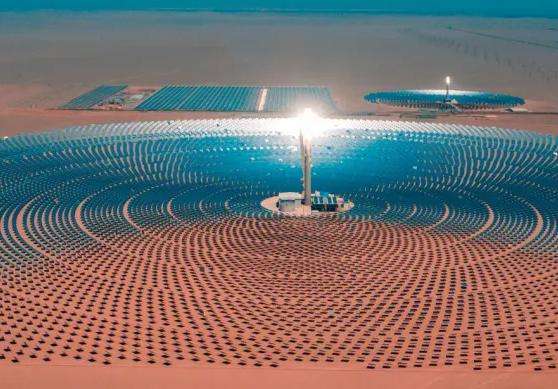1. Build gates and dams to raise the water level, divert water to the generator via pipelines, obtain electrical power through the impact of water flow on the turbine, then transmit to users of electricity via the electricity network. The generator can be placed behind the dam, on the body of the dam, on the bank embankment, etc.
2. Divert water directly to the generator via the water diversion pipe.
The 16 production units of 1,000,000 kilowatts of the Baihetan hydroelectric power station have been installed. What are the technical difficulties behind the project?
When water with potential energy or kinetic energy is injected into the turbine, the turbine begins to rotate. If we connect a generator to the turbine, the generator can start producing electricity. If we raise the water level to flush the turbine, weWe can see that the speed of the turbine increases. Therefore, it can be seen that the greater the water level difference, the greater the kinetic energy obtained by the turbine and the greater the electrical energy that can be converted. This is the basic principle of hydroelectric power.
The energy conversion process is as follows: the gravitational potential energy of the upstream water is converted into the kinetic energy of the water flow. As the water flow passes through the hydraulic turbine, kinetic energy is transferred to the steam. turbine. The hydraulic turbine drives the generator to rotate and converts kinetic energy into electrical energy. It is therefore the process of converting mechanical energy into electrical energy.
Due to the different natural conditions of hydropower plants, the capacity and speed of hydroelectric generator set vary greatly. Generally, smallHydrogenerators and high-speed hydrogenerators driven by impact turbines mainly adopt horizontal structures, while high- and medium-speed generators mainly adopt vertical structures (see figure). Since most hydroelectric plants are located far from cities, they usually have to power the load via long transmission lines. Therefore, the power system imposes higher requirements on the operational stability of the hydroelectric generator: the engine parameters must be carefully selected. ; The required moment of inertia is large. The appearance of a hydrogenerator is therefore different from that of a steam turbine generator. Its rotor has a large diameter and a short length. The hydrogenerator unit requires a short time to start and connect to the grid, and the operation schedule is flexible. In addition togeneral electricity production, it is particularly suitable as a peak shaving unit and as an emergency backup unit. The maximum capacity of the hydrogenerator unit reached 700,000 kilowatts.
As for the principle of a generator, it is very clear in high school physics. Its operating principles are based on the law of electromagnetic induction and the law of electromagnetic force. Therefore, the general principle of its construction is: using suitable magnetic and conductive materials to form magnetic circuits and circuits that conduct electromagnetic induction among themselves to generate electromagnetic energy and achieve the conversion goal of energy.
The last one million kilowatt unit (No. 9) of Baihetan Hydropower Station successfully passed waterless joint debugging and entered the commissioning stage and of exploitation, marking the achievementvement of the installation of the Baihetan hydroelectric power station. 16 million kilowatt units of the hydroelectric plant Launch of the final sprint towards the goal of full production.
The 16 production units of 1,000,000 kilowatts of the Baihetan hydroelectric power station have been installed. What are the technical difficulties behind the project?
1. It takes a long time and is difficult to build
The construction of the Baihetan Hydropower Station took 11 years. The river is very turbulent and the terrain is relatively rugged. The summer temperature in Baihetan is above 43 degrees, the surface temperature can reach 70 degrees, and the wind is very strong. There are more than 240 strong winds above level 7 all year round. In the sky, the maximum wind strength can reach level 13. To put it more clearly, it can overturn a car. In addition, mudslides are very common.likely to occur during the rainy season. Baihetan is located in the Hengduan Mountains. Its geological conditions are relatively complex and it is also surrounded by earthquake-prone areas. necessary to build such a high arch dam. On-site construction plan is very difficult and many challenges will be encountered during the construction process.
2. Super energy conversion
The key to hydroelectric power plants lies in energy conversion. Imagine that when the water rolling in the upper reaches of the Jinsha River continuously pours into the turbine through the steel pipe under pressure, forming a huge vortex, driving the turbine wheel to rotate at high speed, the Potential energy of water is converted into rotational energy. mechanical energy, which is the most critical factor for the unit to produce electricity. Then the rotor drives thehe generator rotor on the turbine so that it rotates at high speed, thereby converting mechanical energy into electrical energy. One million units means that when a single unit is operating at full load, it can produce up to 1 million kilowatts of electricity per hour. Take Deyang City, Sichuan Province, where TEPCO is located, as an example. A production unit of one million units can generate electricity at full capacity for 365 days, which can meet the electricity demand of Deyang City for a whole year.
Postscript: What you see is that the hydroelectric plant is desperately releasing water, but it is actually tight at the upper limit of the flow that the downstream can handle, and flood waves are contained in its belly, thus avoiding “floods that the downstream cannot withstand”. This effect is called “clipping” in hydraulics. How do you say that? How canCan there be peace in the years, simply because there is a great reservoir which silently bears the burden downstream?














